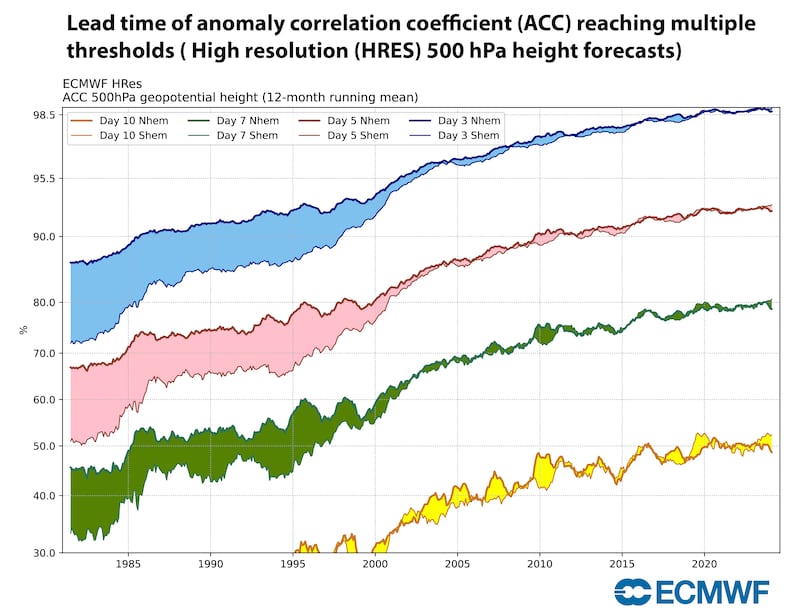Since 1950, there has been a quiet but steady revolution in meteorology, and especially in numerical weather prediction (NWP). The growth in accuracy, range and scope of weather forecasts over the past half-century has been spectacular.
As late as the mid-1970s, forecasts were seriously unreliable. The diagram illustrates the inexorable increase in skill of the computer predictions of ECMWF, the European Weather Centre in Reading. Seven-day forecasts (green) are comparable in accuracy today to five-day forecasts (red) in 2000 and three-day forecasts (blue) in 1980.
Early visionary meteorologists dreamed about scientific forecasting. Norwegian weatherman Vilhelm Bjerknes foresaw that “the fundamental scientific study of atmospheric processes ... has to follow a method based upon the laws of mechanics and physics”.
But what use is calculating tomorrow’s weather if it takes a year to do it? Bjerknes realised the immensity of the computational task but foresaw that “if only the calculation shall agree with the facts, the scientific victory will be won”. He concluded that “it may require years to bore a tunnel through a mountain ... [but] this will not prevent later-comers from riding through the tunnel at express-train speed”.
READ MORE
The express-train for us “later-comers” is the supercomputer. The complexity of modern mathematical models of the atmosphere is vast and ever-increasing: current systems have millions of lines of computer code and the most powerful computers are needed to solve the mathematical equations governing atmospheric flow. Only by banding together, can small national weather services hope to assemble the human resources and acquire the computational machinery required to be at the leading edge of forecasting practice.
United weather centres
Recently, Met Éireann announced a major milestone has been reached in collaboration with three other national meteorological services. The other partners in the United Weather Centres West (UWC-West) collaboration are the National Meteorological Services of Denmark, Iceland and the Netherlands. They have recently commenced operational use of a greatly enhanced weather forecasting model on a new supercomputer, located in Iceland.
The new computer, manufactured by Hewlett Packard, can carry out four thousand trillion calculations per second (that is four followed by 15 zeros, or four PetaFlops in computer jargon), and process 10 million observations per day. The computer, dubbed Aurora, calculates forecasts at a higher level of detail for a much larger area than before. Aurora is powered entirely by renewable hydropower and geothermal energy, so that running costs are low and carbon dioxide emissions are minimal.

The new NWP model is based on the Harmonie-Arome system, which has been under development for more than 20 years by a large group of European met services that includes Met Éireann. The forecast region stretches from Greenland to the central Mediterranean, with grid-points 2km apart and 90 vertical levels. Forecasts are refreshed every hour, allowing frequent updates when new observations arrive.
The aim of modern numerical weather prediction (NWP) is to predict not just the most likely development of the weather but the reliability of that prediction and also the range of alternative scenarios that may arise. To this end, an ensemble of model runs, with slightly different starting values and physical forcings, is carried out. In the new system, the size of the ensemble has been doubled to 30 forecasts.
While the system is now operational, the UWC-West collaboration continues apace. The four weather services continue work together to improve the forecasting model and implement further improvements to it. With the rapid advance of artificial intelligence, forecasting skill is expected to increase significantly over the coming years as AI techniques complement conventional methods.
Peter Lynch is emeritus professor at the School of Mathematics & Statistics, University College Dublin. He blogs at thatsmaths.com
- Sign up for push alerts and have the best news, analysis and comment delivered directly to your phone
- Join The Irish Times on WhatsApp and stay up to date
- Listen to our Inside Politics podcast for the best political chat and analysis













